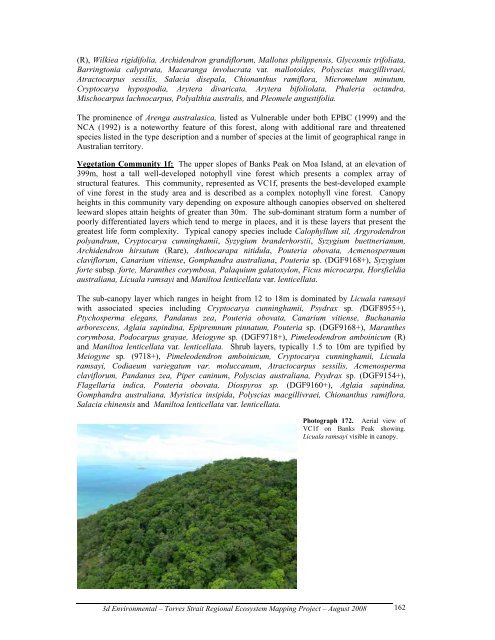Appendix 2 - Vegetation Communities and Regional Ecosystems
Appendix 2 - Vegetation Communities and Regional Ecosystems
Appendix 2 - Vegetation Communities and Regional Ecosystems
Create successful ePaper yourself
Turn your PDF publications into a flip-book with our unique Google optimized e-Paper software.
(R), Wilkiea rigidifolia, Archidendron gr<strong>and</strong>iflorum, Mallotus philippensis, Glycosmis trifoliata,<br />
Barringtonia calyptrata, Macaranga involucrata var. mallotoides, Polyscias macgillivraei,<br />
Atractocarpus sessilis, Salacia disepala, Chionanthus ramiflora, Micromelum minutum,<br />
Cryptocarya hypospodia, Arytera divaricata, Arytera bifoliolata, Phaleria oct<strong>and</strong>ra,<br />
Mischocarpus lachnocarpus, Polyalthia australis, <strong>and</strong> Pleomele angustifolia.<br />
The prominence of Arenga australasica, listed as Vulnerable under both EPBC (1999) <strong>and</strong> the<br />
NCA (1992) is a noteworthy feature of this forest, along with additional rare <strong>and</strong> threatened<br />
species listed in the type description <strong>and</strong> a number of species at the limit of geographical range in<br />
Australian territory.<br />
<strong>Vegetation</strong> Community 1f: The upper slopes of Banks Peak on Moa Isl<strong>and</strong>, at an elevation of<br />
399m, host a tall well-developed notophyll vine forest which presents a complex array of<br />
structural features. This community, represented as VC1f, presents the best-developed example<br />
of vine forest in the study area <strong>and</strong> is described as a complex notophyll vine forest. Canopy<br />
heights in this community vary depending on exposure although canopies observed on sheltered<br />
leeward slopes attain heights of greater than 30m. The sub-dominant stratum form a number of<br />
poorly differentiated layers which tend to merge in places, <strong>and</strong> it is these layers that present the<br />
greatest life form complexity. Typical canopy species include Calophyllum sil, Argyrodendron<br />
poly<strong>and</strong>rum, Cryptocarya cunninghamii, Syzygium br<strong>and</strong>erhorstii, Syzygium buettnerianum,<br />
Archidendron hirsutum (Rare), Anthocarapa nitidula, Pouteria obovata, Acmenospermum<br />
claviflorum, Canarium vitiense, Gomph<strong>and</strong>ra australiana, Pouteria sp. (DGF9168+), Syzygium<br />
forte subsp. forte, Maranthes corymbosa, Palaquium galatoxylon, Ficus microcarpa, Horsfieldia<br />
australiana, Licuala ramsayi <strong>and</strong> Maniltoa lenticellata var. lenticellata.<br />
The sub-canopy layer which ranges in height from 12 to 18m is dominated by Licuala ramsayi<br />
with associated species including Cryptocarya cunninghamii, Psydrax sp. (DGF8955+),<br />
Ptychosperma elegans, P<strong>and</strong>anus zea, Pouteria obovata, Canarium vitiense, Buchanania<br />
arborescens, Aglaia sapindina, Epipremnum pinnatum, Pouteria sp. (DGF9168+), Maranthes<br />
corymbosa, Podocarpus grayae, Meiogyne sp. (DGF9718+), Pimeleodendron amboinicum (R)<br />
<strong>and</strong> Maniltoa lenticellata var. lenticellata. Shrub layers, typically 1.5 to 10m are typified by<br />
Meiogyne sp. (9718+), Pimeleodendron amboinicum, Cryptocarya cunninghamii, Licuala<br />
ramsayi, Codiaeum variegatum var. moluccanum, Atractocarpus sessilis, Acmenosperma<br />
claviflorum, P<strong>and</strong>anus zea, Piper caninum, Polyscias australiana, Psydrax sp. (DGF9154+),<br />
Flagellaria indica, Pouteria obovata, Diospyros sp. (DGF9160+), Aglaia sapindina,<br />
Gomph<strong>and</strong>ra australiana, Myristica insipida, Polyscias macgillivraei, Chionanthus ramiflora,<br />
Salacia chinensis <strong>and</strong> Maniltoa lenticellata var. lenticellata.<br />
Photograph 172. Aerial view of<br />
VC1f on Banks Peak showing.<br />
Licuala ramsayi visible in canopy.<br />
3d Environmental – Torres Strait <strong>Regional</strong> Ecosystem Mapping Project – August 2008<br />
162


